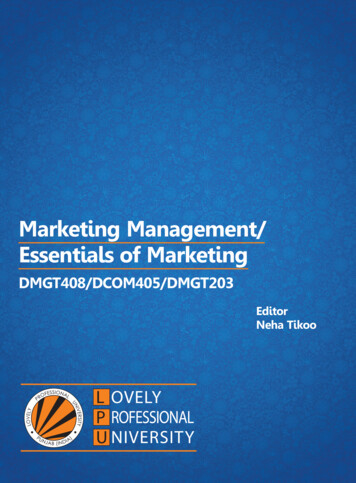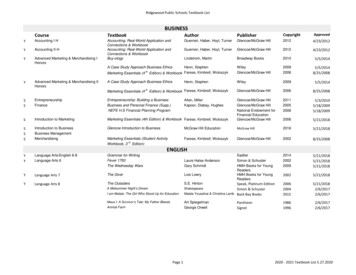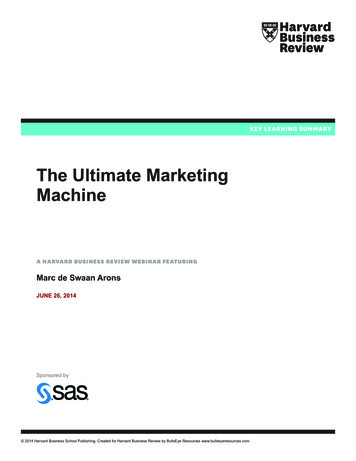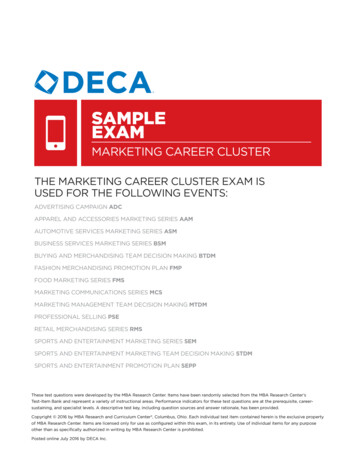
Transcription
Marketing Management/Essentials of MarketingDMGT408/DCOM405/DMGT203EditorNeha Tikoo
www.lpude.inDIRECTORATE OF DISTANCE EDUCATIONMARKETING MANAGEMENT/ESSENTIALS OF MARKETINGEdited ByNeha Tikoo
ISBN: 978-93-87034-74-7Printed byEXCEL BOOKS PRIVATE LIMITEDRegd. Office: E-77, South Ext. Part-I, Delhi-110049Corporate Office: 1E/14, Jhandewalan Extension, New Delhi-110055 91-8800697053, celbooks.comforLovely Professional UniversityPhagwara
CONTENTSUnit 1:Marketing: Scope and ConceptsHitesh Jhanji, Lovely Professional University1Unit 2:Understanding the Marketplace and ConsumersRajesh Verma, Lovely Professional University26Unit 3:Consumer Markets and Consumer Buying BehaviourLokesh Jasrai, Lovely Professional University59Unit 4:Business Markets and Business Buyer BehaviourRahul Sharma, Lovely Professional University81Unit 5:Designing a Customer-driven Strategy and Mix: Creating Value for Target CustomerAjay Chandel, Lovely Professional University99Unit 6:Products, Services and Brands: Building Customer ValueKrishan Gopal, Lovely Professional University124Unit 7:New Product Development and Product Life Cycle StrategiesVishwas Gupta, Lovely Professional University155Unit 8:Pricing: Understanding and Capturing Customer ValueHarvinder Singh, Lovely Professional University178Unit 9:Managing Marketing ChannelsPretty Bhalla, Lovely Professional University197Unit 10:Integrated Marketing CommunicationsHitesh Jhanji, Lovely Professional University229Unit 11:Marketing Communication Tools (Promotion Mix)Pretty Bhalla, Lovely Professional University248Unit 12:Sales ManagementAshwani Panesar, Lovely Professional University272Unit 13:Creating Competitive AdvantageNeha Tikoo, Lovely Professional University289Unit 14:The Global MarketplaceHitesh Jhanji, Lovely Professional University314Unit 15:Sustainable MarketingRajesh Verma, Lovely Professional University330
SYLLABUSMarketing Management/Essentials of MarketingObjectives: Be conversant with the challenges raised by the complexity of the marketing environment for managing productsand services, communications, channel relationships and other marketing mix factors. Display an awareness of conceptualunderstanding and best practices in marketing in managing marketing operations. Demonstrate their ability to use relevantdecision models in recommending appropriate strategies related to marketing mix.DMGT408 MARKETING MANAGEMENTSr. No.Description1.Marketing Scope and Concepts, marketing: creating and capturing customer value, partnering to build customerrelationship2.Understanding the market place and consumers: analyzing the marketing environment, managing marketinginformation to gain customer insight3.Consumer markets and consumer buyer behavior, business markets and business buyer behavior4.Designing a customer driven strategy and mix: creating value for target customer, products, services and brands:building customer value, new product development and product life cycle strategies5.Pricing: understanding and capturing customer value, Pricing strategies6.Managing Marketing Channels, Logistics and Supply Chain Management, Retailing and Wholesaling7.Integrated Marketing Communication, Sales Promotions, Advertising and Public Relations, Sales Management,Personal Selling, Direct and online Marketing8.Creating competitive advantage, The global marketplace9.Sustainable marketing: Social Responsibility and EthicsDCOM405 MARKETING MANAGEMENTSr. No.Description1.Marketing Concepts, Marketing Mix, Marketing Environment2.Strategic Planning Process, Market segmentation and Targeting and positioning3.Marketing Research, Marketing Information system4.Consumer Buying Behaviour, Consumer buying decision process5.Managing product, Product Differentiation and Positioning, New Product Development, Product Life cycle,Managing Brands and Brand equity6.Meaning and Significance of price, Factors influencing pricing, General Pricing Approaches, Pricing Strategies7.Physical Distribution and Marketing Logistics, Marketing Channels, Creating and Managing Dealer Network,Retailing and Wholesaling.8.Integrated Marketing Communication, Sales Promotions, Advertising and Public Relations, SalesManagement, Personal Selling, Direct Marketing9.Marketing Evaluation and Control, Marketing of services10.Recent concepts in Marketing, Global Marketing Strategies for Indian Firms.
DMGT203 ESSENTIALS OF MARKETINGSr. No.1.DescriptionAn overview of marketing, Strategic planning for competitive advantage.2.Social responsibility, Ethics and the marketing environment, developing a global vision.3.Analyzing Marketing Opportunities : consumer decision making, business marketing.4.Segmenting and targeting markets, Decision support systems and marketing research.5.Product concepts, developing and managing products, services and non profit organization marketing.6.Marketing channels and supply chain management, Retailing.7.Integrated marketing communications, Advertising and Public Relations.8.Sales promotion and personal selling.9.Pricing concepts, Setting the right price.10.Customer Relationship Management.
Hitesh Jhanji, Lovely Professional UniversityUnit 1: Marketing: Scope and ConceptsUnit 1: Marketing: Scope and .31.4Defining Marketing-related Factors1.1.1Concept of Exchange1.1.2Barter System1.1.3Needs, Wants and Demand1.1.4Marketing Components1.1.5Marketing TasksMarketing Concepts1.2.1Production Concept1.2.2Product Concept1.2.3Selling Concept1.2.4Marketing ConceptHolistic Marketing Approach1.3.1Marketing Mix1.3.2Marketing Mix Coherency and DynamicsCreating and Capturing Customer Value1.4.1Value Chain1.5Partnering to Build Customer Relationships1.6Summary1.7Keywords1.8Review Questions1.9Further ReadingsObjectivesAfter studying this unit, you will be able to: Define marketing and the related concepts Discuss the marketing concepts State the relevance of customer value and customer satisfaction Explain the concept of value chain Realise how marketing can help build customer relationshipsLOVELY PROFESSIONAL UNIVERSITY1
Marketing Management/Essentials of MarketingNotesIntroductionMarketing is as old as civilization. Though marketing is talked and discussed in business termstoday, its origin goes back to the ancient civilization when man used symbols, signs and materialartifacts to transact and communicate with others. Modern marketing revolves around theconcepts, which are age old. The first signs that man made to communicate with others gavebirth to the idea of marketing. The evolution of marketing has made it a structured discipline tostudy; otherwise marketing did exist in the ancient past.Marketing was also used as a synonym for the art of selling in the past. Even today muchconfusion exists between marketing and selling amongst students of management andpractitioners, regarding the two dominant modes of business and exchange. This unit is anattempt to clarify the doubts in the your mind regarding what marketing is; how marketing hasevolved over a period of time and has come to be known as modern marketing concept. Youwill also be exposed to the real meaning of customer orientation, customer focus and similarconcepts that allow marketing to score higher than selling.1.1 Defining Marketing-related FactorsMarketing starts with customers and ends with customers. Creation of superior customer valueand delivering high levels of customer satisfaction are at the heart of present day marketing. Itis a matter of common sense to appreciate the key marketing success factors. In case a companyreally endeavours to understand customer needs, carefully studies competition, develops andoffers superior value at a reasonable price, makes these products available at places convenientto customers, and communicates with them effectively and efficiently, such products have everyreason to be in demand and will sell consistently.Successful companies have one common trait. They are all very strongly customer-focused intheir orientation. Many other factors contribute to achieving business success, such as developinggreat strategy, committed and skilled human resources, reliable and fast information systems,and excellent implementation and control. But in the final analysis, the focus and dedication ofall these companies is to really understand customers' needs and wants as much as possible andcreate satisfied customers in their target markets.In case someone asks several people what they think marketing is, the chances are these casuallypicked persons will reveal a variety of descriptions in their responses. Probably, the first twoitems describing marketing will be advertising and personal selling, as these two are the mostvisible aspects of marketing for most people. Marketing includes many more activities thanwhat most people realise. The shortest definition of marketing is satisfying consumer needs ina socially responsible way at a profit. Authors of marketing books have defined marketing indifferent words. A few of these definitions are mentioned here.The American Marketing Association defines marketing as: “Marketing is an organisationalfunction and a set of processes for creating, communicating, and delivering value to customersand for managing customer relationships in ways that benefit the organisation and itsstakeholders.”Philip Kotler says, “Marketing is a societal process by which individuals and groups obtainwhat they need and want through creating, offering, and freely exchanging products and servicesof value with others”.Pride and Ferrel's definition says,“We define marketing as the process of creating, distributing, promoting, and pricing goods,services, and ideas to facilitate exchange relationships in a dynamic environment”.2LOVELY PROFESSIONAL UNIVERSITY
Unit 1: Marketing: Scope and Concepts“Marketing is a total system of business activities designed to plan, price, promote, and distributewant-satisfying products to target markets to achieve organisational objectives”.Notes(William J. Stanton, Michael J. Etzel, and Bruce J. Walker, Fundamentals of Marketing,McGraw-Hill, 1994.)“It (marketing) is the whole business seen from the point of view of its final result, that is, fromthe customer's point of view”.(Peter F. Drucker, Practice of Management (1954).The essence of all these definitions of marketing is satisfying customer needs and wants.Apparently, this core objective sounds simple, but it is not. Research shows that in many casescustomers either have inhibitions about revealing their real needs or wants by intent or may notreally know themselves. It is believed that the subconscious is the real storehouse ofdeep-rooted motives. To the extent possible, marketers undertake consumer research and try tolearn about the target customers' needs and wants, and design appropriate marketingprogrammes to satisfy target customers.!Caution Keeping in view the definitions of marketing, some important aspects of modernmarketing can be distinguished:1.Marketing is a societal process.2.Marketing deals with customer needs, wants, products, pricing, distribution, andpromotion.3.Marketing focuses on delivering value and satisfaction to customers through products,services, ideas, etc.4.Marketing facilitates satisfying exchange relationships.5.Marketing takes place in a dynamic environment.6.Marketing is used in both for-profit and not-for-profit organisations.7.Marketing is extremely important to businesses and the economy of acountry.1.1.1 Concept of ExchangeThe concept of exchange is the essence and central to marketing thinking. Unless there isactual or potential exchange, there is no marketing. People can acquire what they need orwant by pursuing socially acceptable behaviours or the behaviours not approved by thesociety. Two socially acceptable approaches of acquiring things include self-producing orexchanging what a person needs or wants. The third method, begging is viewed in somesocieties as a somewhat less than dignified way of acquiring things. The fourth approach mayinclude behaviours such as shoplifting, burglary, or using potentially threatening force, etc.,to acquire things, and these means are totally unacceptable by all civilised societies andpunishable by law. The highly regarded way to acquire what a person needs or wants is theconcept of exchange in marketing context. Both parties in an exchange offer something ofvalue, and freely acceptable to each other. It is understandable that parties involved in anexchange must first agree to terms and conditions laid-down by each party so that actualexchange takes place.LOVELY PROFESSIONAL UNIVERSITY3
Marketing Management/Essentials of MarketingNotesFigure 1.1: Concept of ExchangeSomething of Value(Goods, Service, Ideas, etc.)MarketerBoth Parties Freely Agree to theTerms andConditions of ExchangeCustomer(Money, Credit, Goods, Labour)Something of Value1.1.2 Barter SystemBarter is where people exchanged goods for other goods. It is trading for goods without a fixedprice tag. Some places barter with currencies, and some use only goods to trade with. The oldtrading posts were often barter only, with little currency.In ancient times when money was not invented trade as a whole was on barter system. This waspossible only in a simple economy but after the development of economy, direct exchange ofgoods without the use of money, was not without defects. There were various defects in thissystem. These were the following;1.Double Coincidence of Wants2.Absence of Standard Value3.Indivisibility of Commodities4.Absence of Store of ValueIn the modern economy barter system cannot succeed. Money is indispensable for large scaleproduction. The functions of money are the same which were defects in barter system.1.1.3 Needs, Wants and DemandThe very existence of human beings spells the presence of needs, and marketing thinking startswith this very important realisation. It is wrong to believe that anyone can invent needs. Needsare part of the basic fabric of human life. A need can be defined as a felt state of deprivation ofsome basic satisfaction. This means that unless the individual feels deprived of some basicsatisfaction, at least for this individual, the need does not exist. Humans have a long list of needs,some very basic and others complex. The basic needs are physiological or biogenic in nature,and individuals are born with them. These needs are essential to sustaining human life such asneed for air, water, food, shelter, clothing, and sex. These basic needs are also referred to asprimary needs. Other types of needs are those that individuals learn as a result of being broughtup in a culture and society such as need to belong, acquire knowledge, self-expression, selfesteem, prestige, power, achievement, etc. These are considered as secondary needs, also calledacquired needs and generally believed to be the result of an individual's subjective psychologicalmakeup and relationship with others.Example: To differentiate between need and want, let us assume four individuals arehungry; their need is food. Assuming they have the resources to get involved in acquiring foodto satisfy hunger, they go to McDonald's. One orders a vegetable burger; the second orders a4LOVELY PROFESSIONAL UNIVERSITY
Unit 1: Marketing: Scope and Conceptspuff, the third asks for a chicken burger, and the fourth buys a huge ice cream. All of them areeating some variation of food to satisfy hunger. The specific satisfier that an individual looks fordefines the want. Therefore, wants are specific satisfiers of some needs.NotesIndividual wants are shaped by culture, life style, and personality.Example: An individual buys a Mercedes as a status symbol and a tribal chief in someremote area of Amazon rain forests sticks an eagle feather in his headgear as status symbol.To satisfy any given need, different people may express a variety of wants and the total number ofwants for all sorts of needs is apparently unlimited. Just because people have needs and wants isnot enough to affect exchanges. The resources to acquire the products are limited for everyindividual and hence people want to buy products that they believe will provide the maximumvalue and satisfaction for their money. When the want is backed by purchasing power, it is calledthe demand and marketers are particularly interested in demand rather than just needs or wants.Marketing aims at identifying human and social needs and endeavours to satisfy them bycreating, communicating, and delivering products and services. According to Kotler, marketersare involved in marketing 10 different entities: tangible products, services, events, information,ideas, places, persons, experiences, properties, and organisations to accomplish the objective ofdelivering satisfaction to customers.People buy products only because these are seen as means to satisfy certain needs or wants. Theconcept of product is broad in its meaning and includes everything that is capable of satisfyinga need and can be a physical product, service, idea, person, place, or organisation. Marketersmake a sensible distinction between goods and services to place them in right perspective.Physical products are tangible and services are intangible. People acquire products or buy theservices not so much for the sake of being the owner or consumer, but to derive the benefits theyprovide. Who would buy food just to look at it? No one presumably would buy a refrigerator tojust own it but for the reason that it provides the benefit of protecting the food from becomingstale and keeping it fresh. A large family with more resources will probably buy a bigger twodoor refrigerator, while a nuclear two or three member family with lesser resources mayperhaps want a smaller capacity refrigerator.1.1.4 Marketing ComponentsMarketing is the effective procedure of generating responses, hopefully in a predictable manner.The components of marketing are:1.Ongoing review, Augmentation of business, Marketing Strategies: Continuing to assessthe strengths and weakness of the business and its marketing strategies with reference tocontinuously improving strategies.2.Conducting Market Research: Estimation the size, potential of your customer market andunderstanding the industry and economic drivers with reference to the strengths andweaknesses of your competitors.3.Customer Perspective: Understand the customer perspective. Very often, this is where theseed of innovation begins as we learn more about the customer perspective, we start to beable to identify new, emerging customer needs.4.Differentiating: Standing out from your competitors based on price or value or developinga niche market where you are the dominant player.5.Creating Visibility: Keep your business clearly visible to your target customer groups. Ifnot, what things you need to do to become more visible to each of the customer groupsLOVELY PROFESSIONAL UNIVERSITY5
Marketing Management/Essentials of MarketingNotesthat you serve? E.g., Developing a marketing communications strategy and brandingstrategies will help you do this.6.Developing Channels to Distribute Product/Service: To develop deep and wide channelsfor distributing your product and/or services.7.Establishing a Marketing Budget: Budgeting for the cost of all promotional activity salaries/commissions of sales people, advertising, sales promotions, trade showpromotions, print/media packages, etc.8.Trial, Error: To finance trial, error with your marketing activities to determine whatworks best.9.Tracking Results: Track your marketing results to determine what's working the best.10.Following Through: Keep your promises to your customers with reference to the customerservice and operations providing on-time, quality product.1.1.5 Marketing TasksIn a nutshell, marketing is demand management and the demand for products and services oftenrequires different approaches for a variety of reasons. There may also be other situations wheredemand management would require different types of handling.Example: Demand for hotel accommodation at Mussoorie declines during a severe winter.Philip Kotler and Sidney J. Levy identified eight major demand states in two different articles:1.Negative Demand: This situation is faced when a major part of the target market dislikesthe product and may even pay a price to avoid it. The marketing task is to unearth andanalyse the reasons for this state, and to learn if a product redesign or change in marketingmix elements can help.Example: Unpleasant and painful medical treatment has a negative demand.2.No Demand: The customers may be unaware or indifferent towards the product. The remedyis to create product awareness and connect product benefits to customers' needs and wants.3.Dormant Demand: This may occur when the currently available products fail to satisfy thestrong needs that customers feel. To meet the latent demand more effectively, the marketingtask is to develop product or service if the market size is favourable.Example: Small brands often face no demand situation.Example: Cigarettes with no ill effects.4.Falling Demand: Sooner or later, companies face this situation with respect to their productsor services. The task is to reverse this trend, and marketing should find out the reasons andtake swift remedial action. New markets, product feature modification, or more focusedand effective promotion may hold the solution.Example: There is a falling demand for desktops these days.5.6Fluctuating Demand: Many companies experience this pattern, the demand varyingaccording to the season, or festivals, etc. The task is to synchronise marketing efforts toalter the demand pattern by adopting flexible pricing, and sales promotion techniques.LOVELY PROFESSIONAL UNIVERSITY
Unit 1: Marketing: Scope and ConceptsNotesExample: Air conditioners, Refrigerators, etc. have fluctuating demand.6.Full Demand: This is a situation all companies aspire and work for. The task is to maintainthe level of demand and keep pace with the changing customer preferences and everincreasing competition and monitor customer satisfaction.Example: A situation where the no. of shirts produced by the manufacturers meets thelevel of demand.7.Excess Demand: At this demand level, the company is unable to meet the demand level.The only option usually available is to find ways to decrease demand temporarily orpermanently. Generally, marketing seeks to discourage overall demand throughdemarketing, either by increasing prices or reducing promotion and services. Selectivedemarketing involves reducing demand from those markets that are less profitable.Example: Popular models of cars, like Maruti Suzuki Swift, have excess demand.8.Unwholesome Demand: This concerns managing demand for harmful products. Themarketing task is to make the public aware about the dangers and harmful effects causedthrough misuse or over use of such products by using appropriate degree of fear appeals,price hike, or reduced availability.Example: Cigarettes and other nicotine products.Self AssessmentState whether the following statements are true or false:1.Marketing is a continuous relationship building process.2.Concept of exchange is the central idea behind marketing.3.Human needs are limited.4.The situation where the customer is totally unaware about the existence of a product isreferred to as a negative demand situation.1.2 Marketing ConceptsSince the later part of the 19th century, marketing has gradually evolved through variousmarketing orientations. These stages in marketing evolution present a generalised picture anda sufficiently significant number of companies have adopted the most modern marketing conceptor philosophy.A marketing orientation (also called the marketing concept, or consumer focus) is one thatallows the wants and needs of customers and potential customers to drive all the firm's strategicdecisions. The firm's corporate culture is systematically committed to creating customer value.In order to determine customer wants, the company usually needs to conduct marketing research.The marketer expects that this process, if done correctly, will provide the company with asustainable competitive advantage.This consumer focus can been seen as a process that involves three steps. First customer want areresearched, then the information is disseminated thoughout the firm and products are developed,then finally customer satisfaction is monitored and adjustments made if necessary.LOVELY PROFESSIONAL UNIVERSITY7
Marketing Management/Essentials of MarketingNotesThe concept of marketing orientation was developed in the late 1960s and early 1970s at HarvardUniversity and at a handful of forward thinking companies. It replaced the previous salesorientation that was prevalent between the mid 1950s and the early 1970s, and the productionorientation that predominated prior to the mid 1950s.1.2.1 Production ConceptThis concept, viewed as one of the oldest of managerial orientations, typically aimed at achievingas high an output as possible. This philosophy assumed that customers would be more interestedin acquiring conveniently available, reasonably priced, and well-made products. Keeping inview the market behaviour prevailing in times when customers did not have much choice, itwas a sound approach. The focus of managers, generally having backgrounds in manufacturingand engineering, was to concentrate on achieving increasingly higher efficiency in production,lower production costs, and more intensive distribution. Even today, this approach seems to bequite sensible in relatively underdeveloped and developing economies because customers aremore interested in owning a product and not overly concerned about finer features and aestheticappeal. In general, one important condition seems to be favourable to adopt productionorientation: when the masses look for a cheaper product and demand far exceeds production.Example: In India, The National Textile Corporation (NTC) and all its subsidiaries aresticking to this philosophy while producing textiles for the huge, poverty-stricken populationin this country. Their philosophy and positioning is reflected in their ad, "Clothiers of the nationwith affordable prices." In the global scenario, for nearly three decades Intel Corporation focusedon achieving increasingly high production output of its successive generations of processors soas to bring down the prices of each improved version.The production concept is unlikely to get discarded for a very long time to come, because therewould always be products and populations of such a nature that some companies would feelcomfortable with this philosophy.1.2.2 Product ConceptThe Product Concept has the proposition that consumers will favor those products that offerattributes like quality, performance and other innovative features. Managers focus on developingsuperior products and improving the existing product lines over a period of time. Innovationsin the scientific laboratory are commercialized and consumers get an opportunity to know anduse these products. This is called "Technology Push Model". The problem with this orientation isthat managers forget to read the customer's mind and launch products based on their owntechnological research and scientific innovations. Many times it is observed that innovationsenter in the market before the market is ready for the product. Innovative products are launchedwithout educating the customers about them and the probable benefit or value that the customeris likely to get by using the new products.Example: The Golden Eye Technology was brought to the Indian market by the televisionmajor Onida but the market could not perceive the benefit of this advantage. Subsequently, asthe customers became aware of the various brands and technology related to televisions, LGbrought the new technology to the market and achieved marketing success.1.2.3 Selling ConceptSales concept seems to be based on a lurking apprehension that customers will not buy theproduct in sufficient quantities unless aggressively pressurised. The selling concept was the8LOVELY PROFESSIONAL UNIVERSITY
Unit 1: Marketing: Scope and Conceptsmajor means of increasing sales and profits during 1920s to 1950s in the developed countries ofthat period. Companies believed that the most important marketing activities were personalselling, advertising, and distribution. Selling concept is geared towards converting existingproduct(s) into cash rather than first finding and then satisfying customer needs. Sales concept isoften observed in practice when companies show heavy reliance on their promotional capabilitiesbased on "hard sell" approach. It is obvious that if a company's products do not match thechanging tastes and requirements of customers, with many alternative choices available,managers might be inclined to go for aggressive promotional efforts to sell enough quantities.NotesExample: In his book, The End of Marketing as We Know It, Sergio Zyman writes thatthe purpose of marketing is to sell more stuff to more people more often for more money inorder to make more profit. Of late, this has been happening in case of some Credit Cards in ourcountry.Generally, "hard sell" is often seen in case of products or services that people buy without givingmuch thought to the matter, such as non-essential goods, and tend to postpone such purchases.With ever intensifying competition, products becoming more standardised without anymeaningful differentiation i.e., commoditization, heavy promotional efforts in all possiblemanners are bound to remain the practice, in order to grab more share of the customers' purse.The consequences of "hard sell" might harm the customer base to the extent that, in some cases,they might even bad-mouth the product if the product fails to match up to their expectations.1.2.4 Marketing ConceptAfter World War
Authors of marketing books have defined marketing in different words. A few of these definitions are mentioned here. The American Marketing Association defines marketing as: “Marketing is an organisational function and a set of processes for c










